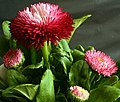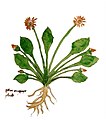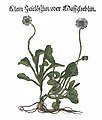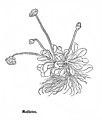daisy
| daisy | ||||||||||||
|---|---|---|---|---|---|---|---|---|---|---|---|---|

Daisies ( Bellis perennis ) |
||||||||||||
| Systematics | ||||||||||||
|
||||||||||||
| Scientific name | ||||||||||||
| Bellis perennis | ||||||||||||
| L. |
The daisy ( Bellis perennis ), also Perennial Daisy , Multiannual Daisy , daisies , Tausendschön , Monatsröserl or Swiss Margritli called ( "Little Daisy"), is a species within the family of the daisy family (Asteraceae). Since it grows on almost every meadow, it is one of the most famous plant species in Central Europe .
description
Appearance and leaf
The daisy is a perennial , herbaceous plant that usually reaches heights of 4 to 15 (2 to 20) centimeters. There are fibrous roots on the short, upright rhizome .
The leaves standing together in a dense rosette are divided into a petiole and a leaf blade. The winged petiole is at least as long as the leaf blade. The simple leaf blade has only one middle nerve, is spatulate to obovate, 6 to 40 millimeters long and 4 to 20 millimeters wide.
Inflorescence and flower
Each rosette of leaves produces continuously ascending to upright, leafless, usually 5 to 15 (3 to 20) centimeters long inflorescence shafts with individual flower heads from March to November.
The cup-shaped inflorescence contains bracts that have a ciliate edge. The more than one hundred flowers are - as is typical of the composites - arranged on the widened stem axis , the so-called inflorescence base. The white, zygomorphic , female, 4 to 8 (up to 11) mm long ray florets are arranged in two rows on the margins . In the center of the flower head there are between 75 and 125 yellow, hermaphrodite and funnel-shaped, radially symmetrical , 1.5 mm long tubular flowers . Two carpels have become an under-earth, einfächrigen ovary grown.
fruit
The fruits are not endowed with a pappus like those of many kinds of the daisy family . The 1 to 2 mm long achenes are crowned closing fruits in which the fruit and seed peel have grown together. The seeds are endospermless .
Chromosome set
The number of chromosomes is 2n = 18.
ecology
What looks like a single flower to a layperson is actually a false flower ( Pseudanthium ). Due to the heliotropism, the flower head is always oriented towards the sun and closes in the evening and in bad weather. The flower heads of Bellis perennis , which bloom from February to November, are visited by bees , bumblebees , hover flies and especially flies . Cross-pollination sometimes takes place during these flower visits. This also helps to a form of self-pollination, the so-called geitonogamy , i. H. the individual flowers within a flower head pollinate each other. Self-pollination within a single flower ( autogamy ) is questionable, but not entirely excluded. As is typical of the composites, the flowers are pre-male, that is, the stamens secrete ripe pollen when the carpels in the flower are not yet ready for pollination. In the case of pollinated flowers, a nut, the so-called achene, develops from the ovary . The daisy uses a number of very different strategies to spread these achenes.
Typical of daisies is the spread of the achenes through the rain. As a result, the achenes in the vicinity of the mother plant are thrown away from her. Another form of propagation takes place through the wind ( anemochory ). The elastic and somewhat elongated stems are moved by gusts of wind and the small achenes are scattered. The achenes are also spread by animals ( zoochory ), especially earthworms , sheep and cattle . After all, even humans help with the spread ( anthropochoric ). The daisy reproduces generatively by seeds (achenes) and vegetatively.
The daisy is attacked by the rust fungi Puccinia obscura with spermogonia and aecidia and by Puccinia lagenophorae with aecidia and telia .
Occurrence
From the genus Bellis , only Bellis perennis occurs outside of the Mediterranean region in Central and Northern Europe . Bellis perennis is considered to be an archaeophyte in Central Europe , which spread to the north in prehistoric times through the creation of extensive meadows and pastures. However, this plant became so common only with the introduction of lawns in gardens and parks. This species was later also introduced by humans in North and South America , along the Pacific coast, on Madeira and New Zealand . She is also a neophyte in Sichuan , Australia, Hawaii and the Azores. Often the spread is not targeted, but rather through contamination of grass seeds by the seeds of the daisy - in technical terms this form of spread is also known as sperochoria .
In the Allgäu Alps , it rises in the Tyrolean part on the Wildmahdalpe to an altitude of 2040 meters.
Preferred locations are pastures, park lawns and gardens on nutrient-rich subsoil, overgrown railway embankments; Regular pruning is necessary, otherwise the grasses and wildflowers will overgrow the low-growing daisies. Since Bellis perennis is a storage plant , it survives winter in the snow. On meadows used for agriculture, it is also a pointer to compacted soils and overused meadows and pastures.
Pointer values according to Ellenberg
| factor | value | scale | Designation / explanation |
|---|---|---|---|
| Light number | 8th | 1-9 | Light plant |
| Temperature number | 5 | 1-9 | Moderate heat pointer |
| Continental number | 2 | 1-9 | oceanic |
| Humidity number | X | 1-12 | indifferent |
| Response number | X | 1-9 | indifferent |
| Nitrogen number | 5 | 1-9 | moderately nitrogenous locations |
| Life form | hp, H | - | Semi-parasite, hemicryptophyte |
Taxonomy
The scientific name Bellis perennis was first published in 1753 by Carl von Linné in Species Plantarum . Bellis ( Latin ) means beautiful, pretty, perennis (Latin) persistent, perennial.
- photos
Daisies and people

Common names
This widespread plant species has a number of popular names that can vary widely from region to region. Typical are Angerbleamerl, Augenblümchen, Himmelsblume, Maiblume, Marienblümchen, Maßliebchen, moonlight flower, morning flower, Easter flower, rain flower, summer rose, sunflower and daisy. Also in Switzerland: Gisegeisseli, Geissemeieli, Geisseblüemli, Geissenblümchen, Mülerblüemli or Margrittli. The Swiss name “Margrittli” (diminutive of “ Margerite ”) obviously comes from the fact that a daisy looks like a scaled down version of a daisy.
The term Maßliebchen is documented as Maßleben, Maßliebchen, Maßlieblin from the 14th century and is probably borrowed from the Central Dutch matelieve into German.
In addition, the other German-language trivial names exist or existed for the plant species, in some cases only regionally : Anblümlein ( Silesia , Swabia ), Angerblume ( Tübingen ), Baumbüllichen, Klein Beinwellen ( Old High German ), Brinkblome ( Low German ), Buntblümlein (Swabia) , Buntblume ( Memmingen ), Chatzablüomli ( Upper Rhine Valley , Untertoggenburg ), Dusendschön ( Holstein , filled variant), Fentjeblöme ( East Friesland ), Fenneblome (East Friesland), White Frueblümlein (Silesia), Early Flower ( Saxony , Daisies (Eichstädt.), Silesian Daisy Lauban , Glogau ), Gänsblümchen ( Graubünden ), Gaisbluomli ( St. Gallen on the Rhine and near Werdenberg ), Gänsegisseli ( Entlibuch ), Gänsegisserli (Entlibuch), Gartenbürstli ( Lucerne , Bern , filled variant), Gasbluoma (St. Gallen near Werdenberg) , Gaseblaume ( Göttingen ), Geissblümli ( Zurich ), Geisgisseli ( Aargau ), Goutkraut, Glotzblume ( Hesse , double variant), Gönsekraut (Göttingen), grass flower, Herzblümle (Henneberg, filled variant), Höppesli ( Schaffhausen , filled variant), Johannisblümli (Graubünden near Laas), Käsblüomli (St. Gallen on the Upper Rhine and near Werdenberg), Kattenblome (Steding, Delmenhorst ), Kirschblümchen, Klawer Blömnik ( Helgoland ), Konradsblume (Halle, filled variant), Konradsblume (Hesse, filled variant), Liebesblümle (Henneberg, filled variant), Maddelencesblümle ( Eifel near Daun ), Maddeseblümchen (Eifel near Altenahr ), Madlinblee, girl's flower (Eifel near Dreis ), Märschblom ( Altmark ), Magdalenenblümchen (Eifel near Daun), Magdelief ( Hamburg ), Magdlieben, Maiblome ( Butjadingen , double variant), Maijenblome ( Bremen ), Maisüsschen (Graubünden), Maliescher (Eifel near Uelmen ), Maltevkes (East Friesland, filled variant), Maneablüamli (St. Gallen in Obertoggenburg ), Margarethel (Swabia), Margarethenklomel (Silesia), Margarithesblume (Eifel near Gillenfeld and Gerolstein ), Margenblaume (Göttingen, Osnabrück ), Margritli (Bern), Marjen, Marienblome ( Münsterland , Unterweser ), Marjenblome (Oldenburg, Osnabrück), Marienblomekens, Marienblömchen ( Westphalia , Thuringia , H Elgoland), Marienblümlein (Swabia), Marienblume ( East Prussia , Pomerania , Hamburg), Marienblümel (Silesia), Marienkrönchen, Markblomen ( Schleswig-Holstein ), Marlblom ( Mecklenburg , Schleswig-Holstein), Marlevkes (East Friesland, double variant), Massblümlein, Masslibigen, Masslieben, Masslieblein, Massüsselen ( Speyer ), Matzelieschen (Nürburg, Eifel), Meargenbläumchen ( Grafschaft Mark ), Merginblum ( Middle High German ), Miärgenblaume Halingen ), Mojleefkis (East Friesland), Monale ( Tyrol ), Montbleaml ( Salzburg ) ,months Glarus , St. Gallen, Graubünden, filled variant), Month flower ( Augsburg ), Month flower (filled variant), Monaterle (Augsburg), MONTELEN (Tyrol near Brixen ), Mosslieb, Mühleblümli (Glarus), Mühlebürstli (Lucerne, filled variant), Mülinblümlin, garbage flowers, Mühliblüamli (St. Gallen, Graubünden), Müllerblüamli (St. Gallen, Graubünden, filled variant), Easter flowers (Silesia), Easter flowers, palm flowers, marigolds ( Ore Mountains ), Rockerl ( Styria ), Ruckerl (Styria), Sametblümli (Lucerne, filled variant), Swiss blue ( Zillertal ), Sommerrösslin (Ore Mountains), Sommerthierlein (Silesia), Tausendschintscher ( Transylvania , filled variant), Tausendschönchen (Lucerne, filled variant), Wandeleien (Saxony), Wasenblümli (Lucerne), Wiesali (St. Gallen near Sargans ), winter crown , Zeitlösslin ( Westrich ), Zeitlose (Graubünden) and cytlose herb.
Use as a food crop
The daisy is occasionally used as a fodder plant. It can also be used in salad . The young leaves taste best from inside the rosette . The flowers are also edible. The buds and the half-open flowers taste pleasantly nutty, while the open flowers taste slightly bitter, which makes them ideal for adding to salads. Pickled buds are sometimes used as a substitute for capers .
Use as a medicinal plant

The tubular flowers contain the saponin bayogenin , essential oils , bitter substances , tannins and mucus . In addition, as in many Asteraceae, the apigenin-7 glucoside cosmosiin was detected in the flowers . In more recent studies, antimicrobial and antihyperlipidemic effects could be shown for Bellis perennis .
Daisy blossoms are used in folk medicine as a remedy for skin diseases, painful or absent menstrual periods, headaches, dizziness and insomnia. The daisy is also used for cough solution, which is primarily due to the saponin content. Efficacy in these areas of application has not been proven. The flowers of the daisy (Flores Bellidis) are commonly used as a tea drug, and a mother tincture is obtained from the fresh plant for homeopathic use.
The daisy is the medicinal plant of the year 2017.
Representations
Royal tombs in Ur from the third millennium contained a golden headdress adorned with daisies. A very old 16-petalled form of the daisy can be found as the most common element on the Ištar gate as a symbol of Ištar.
The daisy achieved undreamt-of fame when it was introduced by the French King Louis IX. (1214–1270) was included in his coat of arms along with the lily . For this he had a ring made with a braided flower wreath.
Superstition
The daisy is one of the first heralds of spring and it is said that if you eat the first three daisies in spring, you will be spared toothache, eye problems and fever for the rest of the year. And who wore dried daisies with him that at St. John's were picked noon 12-13 clock, which would no important work wrong.
The daisy is also used as an oracle by plucking the individual petals of a flower in conjunction with alternating counting rhymes (for example: ... loves me, doesn't love me, loves me ... ).
history
Pliny the Elder wrote in the 1st century: “The daisy (" bellis ") grows in the meadows and has a white, somewhat reddish bloom. Launched with «artemisia», it should be more effective. "
In an Alsatian manuscript from the 1st quarter of the 15th century, the daisy was called "Citelosen": "Citelos en water drunk from the krute burned good for the sore people and heals the disturbed blood and softens the body."
In Nikolaus Frauenlob's “Elixir” the daisy was referred to as “Allermaneyd plue” (“Every month's blossom”). Woman praise attributed 11 virtues to him:
- Prepared as an ointment against flaky facial skin.
- As an ointment against "sprinczel" [ freckles ].
- Drunk as a decoction against coughs, especially in children.
- Prepared with ox bile as an ointment against “swarcz blemishes on the face” [ age spots? ].
- The decoction of the herb drunk to pass stool or the root eaten to stimulate urination.
- Often eaten against "luxuria" [ lust, indulgence ... ]
- The juice or the hot plant as a topping for "crazy glidern" [ contortions ].
- The crushed plant with the juice as a support for broken bones.
- The crushed root as a support for broken fragments ("pull out the broken pain").
- Eaten together with lactuca is effective against many diseases.
- The seeds boiled in wine were drunk against all "schedlich sleg ader würff".
The Gart der Gesundheit , published in Mainz in 1485, reproduced the daisy true to life. In little Destillierbuch of Hieronymus Brunschwig the daisy "Consolida minor" was called, which his wound-healing effect was meant. The fathers of botany ( Otto Brunfels , Hieronymus Bock and Leonhard Fuchs ) also classified the daisy under the heading "Consolida minor". Like Brunschwig, Bock added the forest sanicle to this category.
In his unillustrated herbal book published in 1539, Hieronymus Bock described the daisy so impressively that an illustration became superfluous:
- “The ones who love to measure in the awen vnd moist grass gardens / those who somehow… have geele eyes like chamomiles / and around them are adorned and clad with small white or red body colored bletlins. The e blümlin can be found ſchier through the whole jar / but against the spring on the meyſten. ſind ſtöcklin with thick felt or cautious white roots / like the plantain roots. The herb ſchweitzer green lynd vnnd weych. In the first, before it starts to bloom / it on the earth, it is prepared / looked like a beautiful ter. But that herb a little breytter then dz common Meüß örlin. ſtost zům erſten green buttons as flax bollen / the dough onf thin round ſtengelin over me ſpension high or less / vnd thůn ſich auff zů flow / which ſo ſie ſind in time / felt the gel in it (which seed iſt planted) / vnd ſelbs / like the field chamois. "
- Historical illustrations
Vitus outlet 1479
Garden of Health 1485
Left: Hortus sanitatis , Strasbourg edition 1497. Right: Hieronymus Brunschwig Small Distilling Book 1500
Otto Brunfels 1532
Leonhart Fuchs 1543
Hieronymus Bock 1546
literature
- Angelika Lüttig, Juliane Kasten: Rose hip and Co. Flowers, fruits and spread of European plants . Fauna-Verlag, Nottuln 2003, ISBN 3-935980-90-6 .
- Gertrud Scherf: meadow flowers. The somewhat different nature guide. BLV, Munich 2004, ISBN 3-405-16909-7 .
- Jenny-Dewajana Wild: Phenology, pollination and reproductive biology of Asteroideae (Asteraceae) at different altitudes in southern Germany . - Dissertation, Ulm University 2005 (download) .
Web links
- Bellis perennis L., daisy. In: FloraWeb.de.
- Daisies . In: BiolFlor, the database of biological-ecological characteristics of the flora of Germany.
- Profile and distribution map for Bavaria . In: Botanical Information Hub of Bavaria .
- Bellis perennis L. In: Info Flora , the national data and information center for Swiss flora .
- Distribution in the northern hemisphere from: Eric Hultén, Magnus Fries: Atlas of North European vascular plants. 1986, ISBN 3-87429-263-0 at Den virtuella floran. (Swedish)
- Thomas Meyer: Data sheet with identification key and photos at Flora-de: Flora von Deutschland (old name of the website: Flowers in Swabia ).
- The daisy in folk medicine.
Individual evidence
- ↑ Bellis perennis L., Perennial Daisy. In: FloraWeb.de.
- ↑ a b c d e Gerhard Wagenitz (Ed.): Illustrated flora of Central Europe. Pteridophyta, Spermatophyta . Founded by Gustav Hegi. 2nd, completely revised edition. Volume VI. Part 3: Angiospermae, Dicotyledones 4 (Compositae 1, General Part, Eupatorium - Achillea) . Paul Parey, Berlin / Hamburg 1979, ISBN 3-489-84020-8 , pp. 29–35, 350 (published in deliveries 1964–1979).
- ↑ a b c d e f g h Luc Brouillet: Bellis . In Flora of North America Editorial Committee (Ed.): Flora of North America North of Mexico . Volume 20: Magnoliophyta: Asteridae, part 7: Asteraceae, part 2 (Astereae, Senecioneae). Oxford University Press, New York / Oxford a. a. 2006, ISBN 0-19-530564-7 , Bellis perennis , p. 23 (English, online ).
- ↑ Peter Zwetko: The rust mushrooms Austria. Supplement and host-parasite directory to the 2nd edition of the Catalogus Florae Austriae, III. Part, Book 1, Uredinales. (PDF; 1.8 MB).
- ↑ Bellis in the Germplasm Resources Information Network (GRIN), USDA , ARS , National Genetic Resources Program. National Germplasm Resources Laboratory, Beltsville, Maryland. Retrieved February 23, 2018.
- ↑ Erhard Dörr, Wolfgang Lippert : Flora of the Allgäu and its surroundings. Volume 2, IHW, Eching 2004, ISBN 3-930167-61-1 , p. 566.
- ↑ Carl von Linné: Species Plantarum. Volume 2, Lars Salvius, Stockholm 1753, p. 886 ( digitized version ).
- ↑ Entry Gänseblümchen on the naturheilkraut.com website, accessed on March 30, 2012.
- ↑ From “aabändle” to “Aaheulig” to “hüütze”. Article in the Basellandschaftliche Zeitung from November 6, 2009
- ↑ Entry in Schweizerischer Idiotikon Volume 5, Column 76, Line 9
- ↑ As an example: Use in the novel Das Kreuz des Ostens by Werner Alex Walser, reading sample (PDF; 452 kB) , p. 7.
- ↑ Gänseblümchen Entry in the dialect dictionary of the Swiss Broadcasting Corporation DRS, accessed on March 31, 2011
- ^ Georg August Pritzel , Carl Jessen : The German folk names of plants. New contribution to the German linguistic treasure. Philipp Cohen, Hannover 1882, pp. 55-56, online.
- ↑ T. Schöpke, V. Wray, A. Kunath, K. Hiller: Bayogenin and asterogenic acid glycosides from Bellis perennis. In: Phytochemistry. Volume 31, Number 7, July 1992, pp. 2555-2557, PMID 1368391 .
- ↑ Eberhard Teuscher, Ulrike Lindequist: Biogenic poisons. P. 283.
- ↑ Characteristics on heilkraeuter.de
- ↑ kraeuter-verzeichnis.de: Daisies
- ↑ Neslihan Kavalcıoğlu, Leyla Açık, Fatih Demirci, Betül Demirci, Hülya Demir, K. Hüsnü Can Başer: Biological activities of Bellis perennis volatiles and extracts. In: Natural Products Communications. Volume 5, No. 1, 2010, pp. 147-150, PMID 20184041 , (online) .
- ↑ T. Morikawa, O. Muraoka, M. Yoshikawa: Pharmaceutical food science: search for anti-obese constituents from medicinal foods-anti-hyperlipidemic saponin constituents from the flowers of Bellis perennis. In: Yakugaku Zasshi. Volume 130, No. 5, May 2010, pp. 673-678, PMID 20460863 , doi: 10.1248 / yakushi.130.673 (in Japanese).
- ↑ Thomas Schöpke and Karl Hiller. Bellis . In: Rudolf Hänsel , K. Keller, H. Rimpler and G. Schneider (Eds.) Hager's Handbook of Pharmaceutical Practice . 5th edition, Springer, Volume 4 Drogen AD, Berlin etc. 1992, pp. 476-479 ISBN 3-540-52631-5
- ^ Certificate of the NHV
- ^ Penelope Hobhouse: Gardening through the Ages. Simon & Schuster, London 1992, ISBN 0-671-72887-3 , p. 16.
- ↑ Pliny. Naturalis historia . Book XXVI, § 26 (Chapter XIII) (Digitized Latin) ( Digitized Edition Külb 1840–1864 (German))
- ↑ Frankfurt Ms. Germ. qu 17, Alsace 1st quarter of the 15th century, sheet 342rb (digitized) . In the Small Distilling Book , Strasbourg 1500, Hieronymus Brunschwig took over the indications of the Alsatian manuscript under the letters C, D and F. Sheet 122v-123r (digitized version)
- ↑ Heidelberg Cpg 583, Mattighofen (Bavaria) (1482–1486), sheets 17r-17v: Allermaneydplüe digitized
- ↑ For Niklaus Frauenlob see: Manuscript census (digitalisat) : 4 entries, including Cpg 583.
- ↑ Part-Edition (only Steinbuch): Gerold Hayer, Elixir Nicolay Frawenlob von Hiersperg … In: Contributions to Medieval Studies and German Linguistics… (Göppinger Works on German Studies 304) Göppingen 1980, pp. 185–265.
- ↑ Gart der Gesundheit . (Mainz 1485). Edition Augsburg (Schönsperger) 1485, cap. 333 (digitized version)
- ↑ Hieronymus Brunschwig . Small distilling book . Strasbourg 1500, sheet 122v-123r (digitized version )
- ↑ Otto Brunfels . Contrafeyt Kreueterbuch. Strasbourg 1532, p. 292 (digitized version)
- ↑ Hieronymus Bock . New Kreütter book. Strasbourg 1539, book I, cap. 52 (digitized version)
- ↑ Leonhart Fuchs . New Kreütterbuch. Strasbourg 1543, Cap. 53 (digitized version)
- ↑ Small hawkweed
















